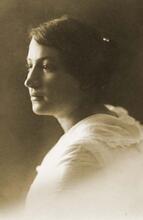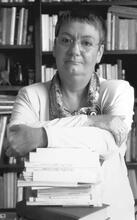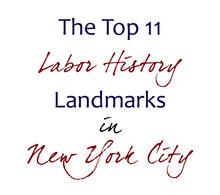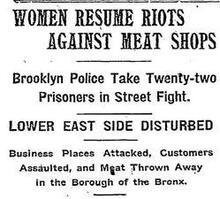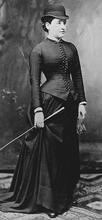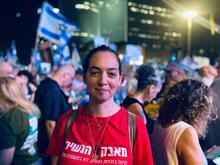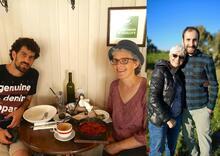Peace Movements in Israel
Though Israel has been involved in a state of protracted conflict and in a cycle of wars since well before its establishment in 1948, a massive peace movement emerged only in 1978. Until then, peace activities were limited to the Communist party and Matzpen, whose agendas were anathema to the general Jewish-Israeli public. A women’s peace movement emerged during Israel’s war in Lebanon with the establishment of Mothers Against Silence, which created a discursive space in which motherhood was politicized and turned into a legitimate resource to engage in issues of peace and security. Throughout the years, the various Israeli peace movements and organizations have focused on anti-militarism and electoral politics as well as on broader cultural shifts within Israeli society.
Women’s peace movements began to emerge gradually in the Israeli protest arena at the beginning of the 1980s, gathering momentum during the 1990s. The mobilization of all-women’s groups for the advancement of peace occurred simultaneously with their intensive participation in the various organizations of the peace camp in Israel. This article will describe and analyze the ways in which women’s peace organizations mobilized, subverted, and changed the social identities constituted by the incorporation of Israeli-Jewishness into citizenship (Helman 1999).
Historical Context to Peace Movements
Though Israel has been involved in a state of protracted conflict and in a cycle of wars since its establishment in 1948, a massive peace movement emerged only in 1978. Until then, peace activities were limited to organizations such as the Communist party and Matzpen, whose agendas were anathema to the general Jewish-Israeli public. From 1948 to 1978, political space was closed to peace initiatives, while the political elite displayed a unified opinion regarding the solution to the Arab-Israeli conflict. The predominant element in their attitude was the view that, since Israel is surrounded by non-democratic, hostile states that wish to destroy it, only the establishment of democratic regimes in the surrounding Arab countries could bring about a peaceful solution of the Arab-Israel conflict. Therefore—the argument went—there was not much Israel could do to advance peace; rather, it had to mobilize most of its resources to ensure its survival. Peace would be achieved only in an almost utopian future (Kimmerling 1993). Another assumption that loomed large was that the Arab-Israel conflict could be resolved only by force and military might (Ben-Eliezer 1995). The belligerent mood of most Arab states, as well as the polarization of the international arena by the Cold War and the power contest between the United States and the Soviet Union, only strengthened the basic assumptions regarding issues of war and peace.
The 1967 Six Day War bore paradoxical results. On the one hand, Israel’s military victory and the expansion of its boundaries brought about the glorification of the army and of all things military. On the other hand, the occupation of the Gaza Strip, the West Bank, the Sinai Peninsula, and the Golan Heights, the control and management of populations under military rule, and the establishment of Jewish settlements gave rise to small protest movements that conceived of the newly occupied territories as a bargaining chip in peace negotiations. It was at this period that the well-known formula “Territories for peace” (i.e. withdrawal from occupied territory in exchange for a peace agreement) began to crystallize and was adopted by the ruling Labor Party.
The 1973 Yom Kippur War shattered the illusion that territorial depth and expanded boundaries could guarantee the security of Israel. The war’s devastating results (2,569 fallen soldiers) sowed the seeds for the reconsideration of the entire outlook regarding Israel’s role in peace negotiations.
Peace Now
Not until 1978, with the visit of President Anwar Sadat (1918–1981) to Israel and the expectations created by the prospects of peace with Egypt, did the formula “Territories for peace” begin to take hold among wide sectors of the Jewish-Israeli population, especially those identified with the Labor party. The loss of Labor’s hegemony—after 30 consecutive years in government—granted these sectors a more autonomous outlook regarding alternative solutions to the Arab-Israeli conflict. The relative opening of the political space and of allied elites was among the factors that enabled the spread of the formula “Territories for peace” and the emergence of a mass peace movement, Peace Now. This movement was initiated by a group of veterans of the 1973 Yom Kippur War, most of them combat soldiers, officers, and holders of military decorations. In a petition sent to Prime Minister Begin on the eve of his departure for the Camp David peace negotiations with Egypt, the signatories declared their loyalty to the Israel Defense Forces (IDF) but conditioned it on the implementation of peace policies. Moreover, while the petition adopted a consensual and sacred concept in Israeli-Jewish political culture (security), it offered alternative policies and practices to achieve it. It promoted the idea that peace—and not war-preparations and escalation—is the way to true security. The petition succeeded in the formation and mobilization of a consensus across networks and groups all over the country.
The emerging movement, Peace Now, organized massive demonstrations and public events in which the symbols and slogans inscribed in the “Officers’ Letter” were displayed on banners and buttons and elaborated in speeches. Women were prominent among the rank-and-file organizers and demonstrators. However, from the beginning Peace Now marginalized women, initially by embracing the role of the fighter and then through the division of organizational work. The fighter’s role, “naturally” associated with men, excluded women, who were not allowed to sign the “Officers’ Letter” (Reshef 1996). Moreover, while men held leadership roles and maintained contact with the media, women were prominent in the organizational tasks. In this way Peace Now reproduced not only the dichotomy between the public and private spheres, but also the gender hierarchy of Israeli society. However, this situation did not—at the time—engender any attempt by women to challenge their marginalization within the movement, or to formulate their own alternative outlook on peace.
The Emergence of Women’s Peace Movements
The emergence of a women’s movement took place during Israel’s war in Lebanon (1982–1985), a war whose necessity was hotly contested, with differing interpretations coming into conflict. It was the first time a war was conducted under a Likud government and perceived by the center and left wings of Israel’s politics as a “political war,” waged as a political instrument, rather than a defensive war aimed at countering a threat to the nation’s existence. The political leadership was unable to construct the friction with the PLO (after a year of cease-fire in the northern area of Israel) as an existential danger, and thus to universalize it. The war in Lebanon proved to be a landmark in the relationship between the home front and the battlefront; from its first week, small demonstrations were staged, and as the war progressed massive waves of protest swept the country. The motto of the1982 demonstrations was that the war in Lebanon was a “war of choice” (milhemet breirah or the Hebrew equivalent to an “unjust war”).
The protest cycle against the war began to gain momentum by the end of its second week, and huge demonstrations swept the country. In May 1983, almost a year after the war broke out, a new movement, Parents Against Silence (later Mothers Against Silence), joined the protest cycle (Gillath 1991; Zuckerman-Bareli and Benski 1989). A letter sent to three daily newspapers by the mother of a soldier triggered the movement. The letter clearly stated the contradiction that beset motherhood in Israel. It emphasized the mounting tension within the Zionist Left between the pursuit of coexistence and peace with the Palestinians on the one hand and, on the other, loyalty to the IDF and to the role of the fighter. The mother called upon parents concerned for their sons’ lives to end their silence, to take responsibility, and to protest against “this accursed war.” The letter succeeded not only in the formation of consensus across networks of parents throughout the country but also in mobilizing them for action. The movement, which especially mobilized women, most of them Jews of European origin and their descendants, including most of North and South American Jewry.Ashkenazi and highly educated, was identified as “Mothers Against Silence.” By mobilizing motherhood, the movement made use of the social identity of Israeli-Jewish women (Berkovitch 1997). Republican motherhood was turned into an oppositional symbol and mobilized to challenge the war.
Mothers Against Silence created a discursive space in which motherhood was politicized and turned into a legitimate resource to engage in issues of peace and security (Helman and Rapoport 1997). While the politicization of motherhood challenged the war politics of the state, it did not challenge the militaristic gender order. Moreover, Mothers Against Silence did not mobilize motherhood for the sake of peace or as a universal symbol that expressed concern for all children. The politicization of motherhood reflected the concern of mothers for their sons in what was defined as a war of choice (Gillath 1991). However, it set a precedent for the mobilization of women and the crystallization of autonomous women’s voices on issues formerly closed to them in Israel, such as peace and national security. Thus the shortcomings of extant movements paved the path for an expansion of the agenda and for the mobilization of new movements that challenge, subvert, and expand the range of actors and identities displayed during cycles of protest. Such was the case with the remarkable expansion of women’s movement during the first Intifada (1987–1993).
Peace Discourse after the First Intifada
The Intifada (Palestinian Popular Uprising) erupted after twenty years of Israeli occupation of the West Bank and the Gaza Strip. The uprising underscored the cost of Israel’s occupation of the territories. The attempt to pacify the occupied territories and to suppress a civil uprising by military means brought to every Israeli home images of violence, harassment, and massive violations of human rights. Since the occupied territories were not considered external to Israel but were defined as frontiers (Kemp 1999), the deployment of military violence and the concomitant violations of human rights brought about not only a revitalization of the activity of mixed-gender peace organizations such as Peace Now and Dai la-Kibbush (Stop the Occupation), but also the emergence of new movements such as The Twenty-First Year (for an extended account see Sasson-Levi 1995) and the proliferation of women’s movements, targeting different aspects of the uprising.
The women’s organizations that compose the inter-organizational peace field bear some similarities, despite their variations. The symbolic concept framing the activities of the various organizations substituted women for mothers. While this substitution may appear merely rhetorical, it carried significant consequences, since it enabled a break through national boundaries and solidarities. Thus, some of the organizations created inter-communal and trans-national spaces in which Israeli Jews, Palestinian citizens of Israel, and Palestinian women from the West Bank and the Gaza strip met and conducted joint activities (Emmett 1996). Moreover, while the activists in most of the organizations were Israeli-Jewish women, their agenda crossed national boundaries, thus giving rise to the emergence of a women’s alternative on issues of peace and allowing for cooperation across national solidarity lines. Moreover, most of the organizations were loosely institutionalized and emerged mostly around specific traumatic events. As a result, the peace camp in general and the women’s peace movement in particular are made up of a variety of organizations that fade away and are replaced by alternative organizations. Membership in these organizations overlapped, as many women were members of more than one organization. There was a hard core of a several hundred of activists, with no single axis of organization and struggle uniting them (Herzog 1999).
Women in Black and Other Organizations
This loose organizational structure, while limiting the mobilizing potential of the women’s peace movement, enabled women to conduct a wide variety of activities and to mobilize rapidly in case of specific and traumatic events. According to Chazan (1991), women’s peace activism during the Intifada became prominent in four types of organizations: political parties, professional organizations, protest movements, and women-only peace organizations. While women’s activism in mixed-gender organizations increased, the most conspicuous phenomenon was the emergence of women’s peace organizations. These included Women for Political Prisoners, Shani—Israeli Women Against the Occupation, and The Israel Women’s Peace Net (Reshet). These organizations dealt with varied issues, such as legal and humanitarian assistance to female political prisoners, education, and the creation of a “transnational space” in which Israeli-Jewish and Palestinian women met, dialogued, and articulated messages such as the right of self-determination and security for all the peoples in the region (Emmett 1996; Herzog 1999). However, they did not engage in overt protest.
The most outstanding female protest movement during the Intifada was Women in Black, a movement inaugurated by a small group of women in Jerusalem in January 1988 (a month after the Intifada broke out), which continued uninterrupted for six years before officially disbanding in June 1994. The purpose of the movement was to protest the Israeli occupation of Palestinian territories and the cycle of Israeli-Palestinian violence, and to prevent the issue from being swept under the national rug. The opposition to the occupation was itself twofold: to decry the oppression of the Palestinian people and at the same time to warn against the concomitant moral corruption of Israeli society.
The central and virtually exclusive activity of Women in Black was the weekly demonstration held every Friday between one and two p.m. in fixed locations throughout Israel. Throughout the six years of its existence, the movement maintained six minimal rules that defined the demonstration anew each week: the time, the site, the silent protest, the black attire, the all-woman format, and the sign “Stop the Occupation.”
The act of protest of Women in Black represented both a challenge and an alternative to the social identities of Israeli-Jewish women as citizens. The symmetry the movement posited between the suffering of both Jews and Palestinians was considered a breach in national solidarity. Moreover, by claiming access to the public sphere and a voice on issues of peace and security, Women in Black challenged the male monopoly over participation in the public realm and the gender division between the spheres. Their demand to voice their opinions on issues of peace and security as citizens of equal standing—not as the mothers or wives of soldiers—undermined both the male monopoly in this realm and the logic that governs gender relations in Israel.
Women in Black constituted a new symbolic type of political woman, whose struggle for her place in the political realm is couched in new terms, not in terms of her domestic identity or any other identity anchored outside the public sphere and the weekly event they performed. The symbolic type of political woman promoted by Women in Black challenged both the political and the gender orders. Moreover, their framework of collective action moved away from militaristic hierarchical symbolism (Helman and Rapoport 1997).
Class and Ethnicity within Israel
The creation of a political space for women and the attempt to forge a voice of their own on issues of peace also had some unintended consequences, such as the silencing of the identities of Lit. "Eastern." Jew from Arab or Muslim country.Mizrahi and Palestinian women. For example, free spaces may empower certain facets of identity while suppressing or silencing others (Polletta 1999). The expansion of the women’s peace movement as well as the active participation of women in mixed-gender organizations disclosed the tensions built into their discursive repertoire. The substitution of womanhood for motherhood enabled the creation of a wider peace agenda that transcended national allegiances and solidarities. At the same time, the expansion of the movement and the inclusion of wider constituencies gave rise to contention over the meaning of women and peace. The political subject promoted by the various women’s peace organizations was deemed to represent the interests of women belonging to the Ashkenazi middle classes, thus oppressing or silencing the interests of wider groups of women, such as Palestinian-Israeli, Mizrahi, and religious women (Emmett 1996). Much as in the case of mixed-gender organizations such as Peace Now, Gush Shalom, and The Twenty-First Year, the expanding women’s movement expressed the changing interests of sectors of the Ashkenazi middle classes (Helman 1999). In this sense, the women’s peace movement in Israel was not unlike “new social movements” in Europe and the United States, composed mainly of the middle and upper middle classes (Offe 1985).
The contention over the meaning of womanhood and peace brought about not the expansion of the basic model of the political subject, but rather the formation of new movements. Particularly important was the challenge posited by Mizrahi feminists (see Mizrahi Feminism), who objected to the one-dimensional agenda of the women’s peace movement and its disregard of the connections between war, peace, class and, ethnicity, or the disengagement between peace and social justice. The marginalizing and silencing of Mizrahi women was multifaceted, beginning with the repertoires of discourse and contention (such as demonstrations on Friday noon and the concentration on peace at the expense of social justice), the division of organizational labor, and the roles assigned to Mizrahi women, mainly as “subcontractors” mobilizing working-class Mizrahi women in peripheral neighborhoods and towns, and ending with their under- or non-representation in leadership positions (Dahan-Kalev 1997; Emmett 1996, pp. 133–170; Shadmi 2000; Shiran 1991).
Palestinian Citizens of Israel
Yet another challenge to the political subject promoted by the women’s peace movement came from Palestinian women citizens of Israel. Some of these women had been active since the early 1950s in Tandi (Democratic Women for Israel), affiliated with the Israel Communist party. However, being Palestinian and also affiliated with the Communist party excluded them and their agenda from the mainstream peace movement that developed during the 1980s (Herzog 1999). It was only during the Intifada that Israeli-Jewish and Palestinian-Israeli women began to cooperate in various protest and dialogue organizations. Israeli-Palestinian women were active in Women in Black, especially in the central and northern part of Israel (Haifa, Acre, Nazareth, and the Galilee) and in small organizations and initiatives such as the Cloth of Peace and Neled (Women for Coexistence). They were also represented in the Women’s Peace Net (Reshet). However, their participation highlighted the dominant conception of the Arab-Israeli conflict as an inter-state conflict, and not as an inter-communal conflict. Moreover, once they began to participate in encounters with Palestinian women of the Occupied Territories, they faced their ambivalent status as Palestinian citizens of Israel. Palestinian-Israeli women, much like Mizrahi women, were marginalized both in leadership roles and in the repertoire of discourse that silenced their multifaceted identities (Emmett 1996, pp. 58–96; Herzog 1999). The younger generation therefore opted for separate Palestinian women organizations.
Thus, not unlike in the case of Mizrahi feminists, the ethnic composition of the main women’s organizations in the peace movement sowed the seeds for future movements (Keck and Sikkink 2000, p. 45). The outstanding aspect of the women’s peace movement during the Intifada was its expansion across different areas and constituencies as well as the contradictions emerging from the subversion of well-established social identities, mainly the adoption of the general motif of womanhood instead of that of motherhood. Moreover, the adoption of womanhood as a repertoire of discourse enabled the participants to question the association between gender and militarism, and to slowly mount challenges to the gender order of Israel and not only to the war and military politics of the state (Deutsch 1994; Emmett 1996).
The Limitations and Opportunities of Electoral Politics
The 1992 general election, the accession to power of a new coalition (Labor-Meretz), and the Oslo Declaration of Principles between Israel and the PLO (1993) brought about a partial demobilization of the peace movement in general and of the women’s movement in particular. Not only were representatives of the peace movement members of the ruling coalition; some of them even held ministerial positions in the new government. This favorable ambience minimized the opportunities for active protest. Women in Black officially disbanded in 1994 but resumed protest vigils in 1995 as the peace process faltered. Concomitantly, and capitalizing on the momentum developed during the Intifada and the new energies released by the Oslo Declaration of Principles, a new organization, Bat Shalom-Jerusalem Women’s Action Center, was established in 1993. Bat Shalom and Markaz al-Quds la L-Nissah (The Jerusalem Center for Women) were part of the Jerusalem Link, an organization established following the success of Reshet during the Intifada.
The goals of the Jerusalem Link were the creation of a culture of peace and cooperation between Israelis and Palestinians. Each organization worked vis-à-vis its own national audience while conducting joint activities with its partner. The activities of Bat Shalom can be characterized as a combination of education (such as leadership training) and protest activities. In this sense, its agenda was wider than those characterizing protest movements. The years 1993–1995 allowed Bat Shalom and other movements to elaborate expanded agendas and to try to reach out to new audiences. However, the attempt to widen the constituency, especially to Mizrahi and working-class women, failed, and Mizrahi activists left the movement, rejecting their role as recruiters of Mizrahi women for the cause of peace who were, however, not granted representation in leadership positions or decision-making forums (Dahan-Kalev 1997, p. 36).
The assassination of Prime Minister Rabin and the attempts to reconstitute the lost unity among Jews in Israel represented a further blow to the already demobilized peace movement. It was only in 1996, after Benjamin Netanyahu was elected as Prime Minister and especially after the events of November 1996 (when the opening of a tunnel at the Western Wall gave rise to a violent Palestinian response), that old-new coalitions emerged. Particularly prominent were Women and Mothers for Peace and Religious Women for Peace. While religious women seeking a peaceful solution to the Israeli-Palestinian conflict usually participated in Netivot Shalom/Oz ve-Shalom, a mixed-gender organization (Emmett 1996), the uniqueness of Religious Women for Peace was in its attempt to initiate a wide educational campaign as well as an alternative reading of religious texts, thus challenging the hegemonic outlook sanctifying the Land of Israel and the exclusive rights of Jews to it.
However, even during this period, peace activism, both of single- and mixed-gender organizations, declined dramatically, mainly as a result of the hopes that the faltering peace process would eventually come to completion. While peace and especially the Oslo Declaration of Principles continued to be hotly contested issues deeply dividing Israeli society, energies were channeled to other aspects of the Israeli-Arab conflict, such as the death toll extorted by the low-intensity warfare in Southern Lebanon. However, not until 1997 did a new cycle of protest begin to gather momentum, triggered by the collision of two military helicopters carrying Israeli soldiers to missions in South Lebanon. The death toll was 73 soldiers. Two months after the collision, a group of women, most of them living in the northern part of Israel, established a movement called Four Mothers, which launched a campaign for the withdrawal of the Israeli forces from Southern Lebanon. The nurturing and care associated with motherhood were diverted and imbued with new content: the well-being of the soldiers was to be protected by bringing the sons back home. Following in the footsteps of previous mothers’ movements but enriched by the experience some of the women had gained during the Intifada protest cycle, Four Mothers not only initiated demonstrations and protest events, but also had as a fundamental part of their agenda challenging to the predominant outlook legitimizing the continued Israeli occupation of South Lebanon. Through intensive learning and data-gathering, Four Mothers began to crystallize an alternative outlook on issues of national security, an act that while not substituting for the hegemonic view began to question it at its margins. Most significant was the access to a territory hitherto monopolized by military elites, and the promotion of an alternative knowledge articulated and promoted by women. It was this step that lent motherhood a subversive turn. Israeli forces withdrew from South Lebanon in May 2000—an act that was interpreted as a success for the movement and that brought about its official dismantling.
Attempts at Cultural Shifts
While protest activity subsided in 1998 and 1999, new radical peace initiatives were developed in what Melucci (1989) has characterized as submerged networks in everyday life. These networks engaged in the elaboration of alternative modes of conceiving personal and collective existence. The militarization of the Israeli state and society, and especially “citizen militarism,” i.e., the outlook that conceives of war and of the institutions of war-making as normal social activities (Kimmerling 1993; Mann 1987), were perceived as requiring an alternative. The emergent movement, New Profile—The Movement for the Civilization of Israeli Society, declared in its charter: “Our name, New Profile, reflects the long-range aim of our organization: to change the profile of Israeli society from a militarized society of war and might to an actively peacemaking community in which the rights of all people are respected and promoted equally, and the military occupation of others’ lands comes to an end” (New Profile 1999).
New Profile set a wide and ambitious agenda, seeking to enquire into the relationship between militarism, inequality, and violent and discriminatory practices that hinder the development of democratic participation. Moreover, the movement maintained that a militaristic mind-set prevents the achievement of real peace in the region. The movement sought to achieve its goals through an array of projects, such as the re-thinking of conscription, an open endorsement of soldiers who refuse to be inducted into military service, and various educational projects that engaged directly with the de-militarization of education and the curriculum (New Profile 1999). This initiative was far-reaching in that it represented a thorough attempt to challenge one of the deepest organizing principles of the social order in Israel (Helman 1997) and aimed to change modes of imagining the personal and collective experience of Israelis (both Jews and Palestinians).
Protest Movements in a Political Vacuum
The new millennium brought with it another cycle of Israeli-Palestinian violence. The failure of the Camp David Talks in July 2000 and the outbreak of the Second Intifada in September 2000 immediately shattered the expectations of a peaceful solution to the Israeli-Palestinian conflict. Prime Minister Barak’s faltering coalition fell and in February 2001 Ariel Sharon was elected prime minister. The new coalition, which included Likud and Labor representatives as well as religious and extreme-right parties, was defined as a National Unity Government. Like earlier governments of this kind, it led to a political stalemate, accompanied by increasing violence. The peace camp, already demobilized under the Barak coalition, was slow in its reaction to the mounting cycle of violence. Suicide bomber attacks on Israeli urban centers, combined with the delegitimization of Yasser Arafat as a partner for peace, drained the peace camp’s energies and massive constituency.
This political vacuum was filled by women’s protest movements united, in theory, in the Coalition of Women for Just Peace, a coalition that comprised Bat Shalom, Women in Black, New Profile, WILPF (Women’s International League for Peace and Freedom), Tandi (Democratic Women for Israel), Noga Feminist Magazine, Women for Coexistence (Neled) and Mahsom Watch. The coalition initiated both small and massive public events, thus ensuring that alternatives to violent conflict would not be swept under the rug. However, each organization maintained its independence, and most disappeared over the following years. Those that continued to exist protested against both the occupation of the West Bank and Gaza and the military campaign launched against the Palestinian Authority. Most were based on an agenda that combined feminist themes (participation of women in peace negotiations and equality for women); anti-militarism and de-militarization of Israeli society; social justice and equality; and full inclusion of the Palestinian citizens of Israel (Coalition of Women 2000). This agenda was wider than that promoted during the previous three and a half decades by any peace protest movement in Israel.
One of the bi-national components, the Jerusalem Link, decided to seek international support and linked up with UNIFEM (the United Nations Development Fund for Women), creating the International Women’s Commission for a Just Peace in the Middle East. This Commission was composed of 20 Israelis, 20 Palestinians, and 20 internationals, including two heads of state. The Commission prided itself on speaking in one voice, but doing so became increasingly difficult— especially when Israel led armed attacks on Gaza. Unable to overcome these difficulties, the Commission dissolved itself, although its leaders, long-time peace activists like Hanan Ashrawi, Naomi Chazan, and Galia Golan, continued to be active in other frameworks.
After twenty years of activity, the women’s peace movement in Israeli managed to expand and become a significant actor in the Israeli public sphere. This expansion has been accompanied by the mobilization, subversion, and change of the identities constituted by the incorporation of Israeli-Arab women and even Jewish women settlers into the mainstream and prominent Women Waging Peace movement. Womanhood substituted for motherhood, thereby enabling the articulation of agendas that transcended national allegiances and solidarities. The only other organization created during the intifada that survived was Machsom Watch. Especially during the Second Intifada, this group assumed importance, becoming increasingly political, even radical, despite its attempt to appeal to mainstream women.
The decade from 1992 to 2002 was marked by the incorporation of an overt feminist outlook, enhancing a critical analysis of the militaristic character of Israeli society. Notwithstanding its limited appeal, the women’s peace movement in Israel became one of the innovative forces in Israeli society, constantly striving for new ways of imagining its collective identity. It may be concluded that the exclusion of women from the political arena, which is still dominated by military men, has empowered them and contributed to a different outlook on the central problems of Israel. It also led to the creation of women’s groups within some of the predominantly male peace groups, and to the near monopoly of men over matters of war and peace remains. By definition, men are still assumed to be former warriors or past/future combatants, but the contribution of women in the extra-parliamentary sphere has become more evident, primarily through the mainstream Women Waging Peace as well as Machsom Watch.
Ben-Eliezer, Uri. The Emergence of Israeli Militarism 1939–1956 (Hebrew). Tel Aviv: Dabir, 1995.
Berkovitch, Nitza. “Motherhood as a National Mission: The Construction of Womanhood in the Legal Discourse of Israel.” Women Studies International Forum 20 (1997): 605–619.
Chazan, Naomi. “Israeli Women and Peace Activism.” In Calling the Equality Bluff: Women in Israel, edited by B. Swirski and M. P. Safir, 152–161. New York: Teachers College Press, 1991.
Coalition of Women for Just Peace in the Middle East. “Principles of the Coalition.” 2000.
Dahan-Kalev, Henriette. “The Oppression of Women by Other Women: Relations and Struggle between Mizrahi and Ashkenazi Women in Israel.” Israel Social Science Research 12 (1997): 31–44.
Deutsch, Ivonne. “Israeli Women Against the Occupation: Political Growth and the Persistence of Ideology.” In Women and the Israeli Occupation, edited by T. Mayer, 88–105. London: Routledge, 1994.
Emmett, Ayalah. Our Sisters' Promised Land: Women, Politics and Israeli-PalestinianCoexistence. Ann Arbor: University of Michigan Press, 1996.
Gillath, Nurith. “Women Against War: Parents Against Silence.” In Calling the Equality Bluff: Women in Israel, edited by B. Swirski and M. P. Safir, 142–146. New York: Teachers College Press, 1991.
Golan, Galia. “Asymmetry in Cross-Conflict Collaboration: Is There a Gender Factor?” Peace and Conflict Studies, Vol. 18, No. 2, Fall 2011, 164-191.
Golan, Galia and Zahira Kamal. "Bridging the Abyss: Palestinian-Israeli Dialogue." In A Public Peace Process: Sustained Dialogue to Transform Racial and Ethnic Conflicts, edited by Harold Saunders, 197-220. New York: St. Martin's Press, 1999.
Helman, Sara. “Militarism and the Construction of Community.” Journal of Political and Military Sociology 25 (1997): 305–332.
Helman, Sara. “From Soldiering and Motherhood to Citizenship: A Study of Four Israeli Peace Protest Movements.” Social Politics 6 (1999): 292–313.
Helman, Sara and Tamar Rapoport. “Women in Black: Challenging Israel’s Gender and Socio-Political Order.” British Journal of Sociology 48 (1997): 681–700.
Herzog, Hannah. “A Space of Their Own: Social-Civil Discourses among Palestinian Israeli Women in Peace Organizations.” Social Politics 6 (1999): 344–369.
Herzog, Hanna and Ronen Shamir. “Negotiated Society? Media Discourse on Israeli Jewish/Arab Relations.” Israeli Social Science Research 9 (1994): 55–88.
Keck, Margaret and Kathryn Sikkink. “Historical Precursors of Modern Transnational Social Movements and Networks.” In Globalizations and Social Movements, edited by J. A. Guidry, M. D. Kennedy, and M. N. Zald, 35–53. Ann Arbor: University of Michigan Press, 2000.
Kemp, Adriana. “The Frontier Idiom on Borders and Territorial Politics in Post–1967 Israel.” Geography Research Forum 19 (1999): 78–97.
Kimmerling, Baruch. “Militarism in Israeli Society.” (Hebrew) Theory and Criticism: an Israeli Forum 4 (1993): 123–140.
Mann, Michael. “The Roots and Contradictions of Modern Militarism.” New Left Review 162 (1987): 35–50.
Melucci, Alberto. Nomads of the Present: Social Movements and Individual Need in Contemporary Society. London: Temple University Press, 1989.
New Profile, Movement for the Civil-ization of Israeli Society. “What We Do: The New Profile Movement to Civil-ize Israel,” 1999.
Offe, Claus. “New Social Movements: Challenging the Boundaries of Institutional Politics.” Social Research 52 (1985): 817–868.
Polletta, Francesca. “‘Free Spaces’ in Collective Action.” Theory and Society 28 (1999): 1–38.
Reshef, Tzali. Peace Now: From the Officers’ Letter to Peace Now. Jerusalem: 1996.
Sasson-Levi, Orna. Radical Rhetoric, Conformist Practices: Theory and Practice in an Israeli Protest Movement. Jerusalem: Hebrew University Press, 1995.
Shadmi, Erella. “Between Resistance and Compliance, Feminism and Nationalism: Women in Black in Israel.” Women’s Studies International Forum 23 (2000): 23 34.
Shiran, Vicki. “Feminist Identity vs. Oriental Identity.” In Calling the Equality Bluff: Women in Israel, edited by B. Swirski and M. P. Safir, 302–311. New York: Teachers College Press, 1991.
Zuckerman-Bareli, Chaia and Tova Benski. “Parents Against Silence.” Megamot 32 (1989): 27–42.

